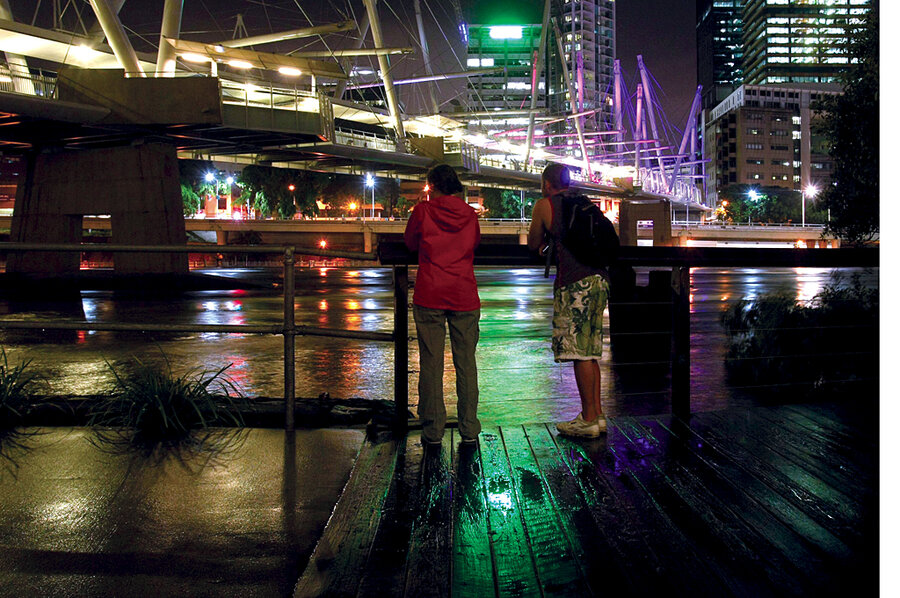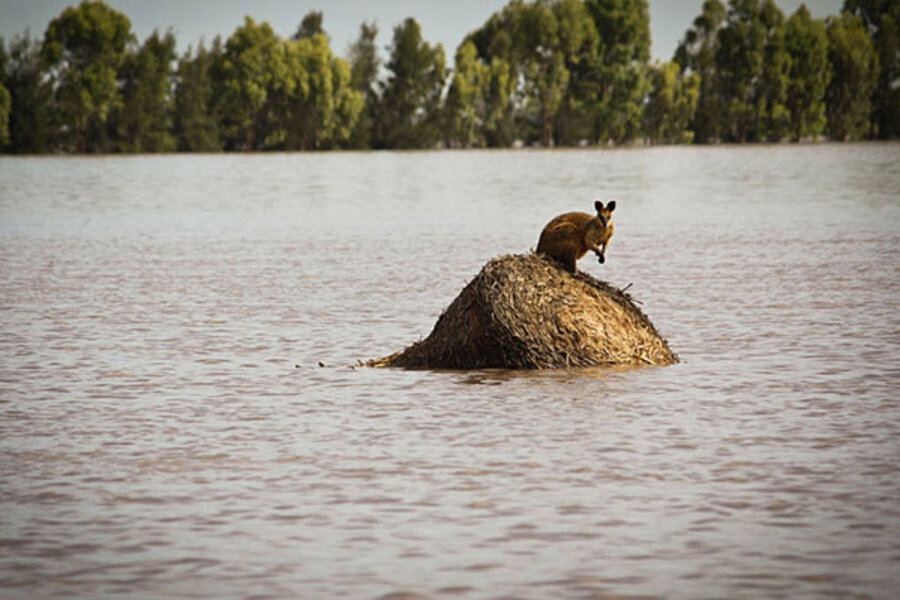Australia's flood aftermath on par with New Orleans
Loading...
| Brisbane, Australia
Last week Colin and Lorna Wilkinson decamped from their 12th floor Brisbane apartment building with little more than their two cats and a few plastic bags.
Despite warnings that Brisbane's worst floods since 1974 were on their way, the couple initially wanted to stay put – but the manager of their building, which is right on the river, told them they had to leave. Recalling the recent graphic TV images of families stranded on rooftops and cars being swept down streets in towns west of Brisbane, Mrs. Wilkinson describes the floods simply as "quite scary."
The Wilkinsons made it to the city's main flood evacuation center, the expansive RNA Showgrounds, along with hundreds of others. Traditionally the site of an annual agricultural fair, the show grounds are now one of five evacuation centers in Brisbane, and one of about 60 in Queensland set up to receive flood evacuees and donations for flood victims.
More than 15,000 properties in 50 Brisbane suburbs have been affected by floodwaters that peaked at 4.46 meters (14.6 feet) on Jan. 13. After weeks of flooding at least 25 people were killed, and some 12 more were missing across Queensland Jan. 18. Now large areas of the city are covered in dirty water and mud and some evacuees have been told by authorities they will not be able to return to their homes for months.
Some experts say the economic impact of the floods spurred by an energetic La Niña weather cycle, currently estimated at $20 billion and rising, could be on a par with the 2005 hurricane Katrina, and from which New Orleans is still recovering (total damage from Katrina is estimated at $81.2 billion).
As affected Brisbanites struggle to come to terms with the loss of their homes, the state and federal governments are planning a massive program to repair and replace roads, railway lines, bridges, and public buildings in and around the towns and cities affected by flooding.
"We now face a reconstruction task of postwar proportions. That is how we are seeing it, and that is the sort of steely determination we will require," stressed Queensland Premier Anna Bligh. Still, she indicated her optimism that it was a doable task, "We're the people that they breed tough, north of the [New South Wales] border. We're the ones that they knock down and we get up again."
The government struggling before the floods to bring the budget back into surplus by 2013, is expected to foot 75 percent of the cost of reconstruction, suggesting that each of 22.5 million citizens could be issued with a bill of around $660 each, according to the Telegraph.
Australian sports stars have been helping to raise money for the relief effort. Australia has not called for international aid, but its neighbor, Indonesia, is donating $1 million.
Assessing the damage
In Fig Tree Pocket, a neighborhood on the outskirts of Brisbane, many homes were submerged. "I felt sick when I first saw my house again," says Marie Gough, who moved out to stay with her son's family. Mrs Gough, went back to visit her home the day after the waters peaked to have a look and saw the tide mark. "The water went right up to my roof," she says.
For her, and for at least 20,000 other Brisbanites, recovery will be slow. First, they have to wait for the floodwaters to recede completely. Then their houses have to dry out. Then they need to be checked for electrical safety. Only then will builders come in and evaluate the damage to kitchens, bathrooms, walls, floors, and ceilings. Some houses may never again be habitable.
Then there is the psychological challenge. Lifeline, an Australian organization that counsels the depressed and suicidal, has reported a surge in calls by those affected.
Still, most evacuees are saying they plan to return to their communities and rebuild their homes.
In Brisbane, the city will be split into five sections so that the damage can be assessed by local authorities. Their task is complicated by the fact that the floods – which began in early December, and have since soaked and isolated scores of small towns – are continuing in many areas.
The Army's role in relief
In scattered rural regions saturated by torrential rain and overflowing rivers, the Army played a leading role in relief efforts, airdropping food and supplies to remote farms. Military helicopters have airlifted people to hospital, including a woman who gave birth in the flooded Lockyer Valley, west of Brisbane. With the area airport closed until the end of January, the Army is trucking in food and fresh water. The government's commitment of 1,200 troops is the biggest domestic disaster relief since 1974.
Across Queensland, citizens have been rushing to help one another. In Brisbane, on the eve of the flood's peak, thousands of people, many with pickup trucks, canoes, kayaks, and even jet skis, descended on vulnerable neighborhoods, rescuing stranded neighbors and ferrying people and their belongings to and from flooded properties. "I'm just blown away by the support I've received from my fellow Australians," said Elizabeth Dempsey, who had herself been helped by strangers.







